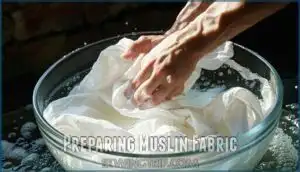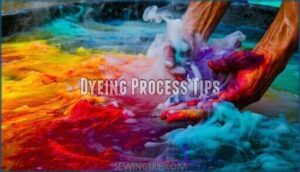This site is supported by our readers. We may earn a commission, at no cost to you, if you purchase through links.

Fill a stainless steel pot with enough hot water to cover your muslin, then add your chosen Rit dye color. You can use powder or liquid forms—just follow package measurements.
Submerge your damp muslin completely, stirring constantly for 30 minutes to guarantee even color. Rinse until water runs clear, then wash with mild detergent.
For darker shades, you’ll need more dye or longer soaking time. Like cooking a perfect sauce, the secret’s in the constant stirring and temperature control. Those special techniques for color-fastness might surprise you.
Table Of Contents
Key Takeaways
- Pre-wash your muslin to remove impurities and ensure even dye absorption.
- Use hot water to prepare the dye bath and stir constantly to avoid uneven coloring.
- Add Rit ColorStay Dye Fixative to lock in color and prevent fading or bleeding.
- Rinse thoroughly with cold water and air dry away from direct sunlight for long-lasting results.
Preparing Muslin Fabric
Before you start dyeing muslin, you’ll need to prepare it properly to guarantee the color absorbs evenly.
Pre-washing your fabric, removing impurities, and choosing the right type of muslin are simple steps that make a big difference in your final result, ensuring complete concepts are applied for the best outcome.
Pre-Washing Muslin
Before dyeing muslin fabric with Rit dye, prewashing is key to guarantee vibrant results.
Start by washing it in warm water with mild detergent to remove sizing and other residues. Maintain the water temperature for effective detergent choice.
Skip bleach usage unless necessary, and always rinse thoroughly to guarantee complete residue elimination.
Proper fabric preparation makes all the difference!
Removing Impurities
Before you dye muslin fabric, inspect it for stains and impurities.
Stain identification lets you tackle tough spots early. Use mild bleach alternatives or soapy water for pre-dye soaking.
Avoid fabric softeners—they leave unwanted residue. Rinse thoroughly for residue removal, ensuring even dyeing.
Clean, impurity-free fabric is the cornerstone of vibrant colors when using Rit dye muslin techniques.
Selecting Right Muslin
When picking muslin fabric, consider its weight and weave tightness.
Lightweight muslin works best for flowy projects, while heavier options add structure.
Tight weaves hold dye more evenly.
Stick to 100% cotton for the best results when dyeing muslin.
Natural or white muslin is ideal, ensuring true color, while darker fabric may shift hues.
Match fabric to your project’s needs, considering the best results.
Dyeing Muslin With Rit
Transforming muslin with Rit Dye is like giving it a vibrant new identity! Begin by prepping a large, stainless steel or enamel pot for the dye bath—essential for safety and consistent color.
Slowly add your chosen Rit Dye colors, stirring to dissolve thoroughly. For bold hues, make certain the water’s hot but not boiling.
Slip your muslin in, verifying it’s fully submerged, and gently stir to avoid uneven patches. Time is key—monitor the fabric often, so the shade matches your vision.
For intricate muslin dye projects, experiment with classic dyeing techniques like ombré or tie-dye, for extra flair! Acid dyes offer permanent color.
Keep a timer handy, stay safe, and remember—rinse with cold water post-dyeing for lasting brilliance. Rit Dye muslin like a pro!
Choosing Right Rit Dye
When choosing the right Rit dye, consider the material and color intensity you want to achieve.
Fiber-reactive, concentrated, and powdered dyes each offer unique benefits, so pick the one that suits your project best.
Fiber-Reactive Dyes
When working with muslin fabric, fiber-reactive dyes stand out for their strong dyeing mechanisms and excellent colorfastness factors.
These dyes chemically bond with cotton fabric, offering vibrant, long-lasting results.
With straightforward application techniques and a low environmental impact, they’re perfect for creative dyeing techniques, and RIT dye’s fiber-reactive options guarantee your muslin projects look professional and stay bold over time.
Concentrated Dyes
Why choose concentrated dyes? These powerful formulas from RIT dye offer unmatched dye strength and allow precise control over color saturation.
Whether you’re aiming for bold hues or softer tones, adjust by dye dilution. Perfect for dyeing muslin at home, their concentrated nature guarantees cost-effective results with versatile application methods, making them the best dye for muslin projects.
Remember that fabric density impacts dye penetration, affecting the final result, which is why precise control and understanding of dye strength are crucial.
Powdered Dyes
While concentrated dyes offer convenience, Rit powdered dyes give you better control over color depth.
Mix the powder with 470 mL of very hot water until completely dissolved for consistent results.
They’re more economical than liquid options but might require extra attention from beginners.
Explore the Rit powdered dye options for your next project.
Two powder packages will dye about 1 kilogram of muslin.
Remember, proper dissolution prevents spotting and guarantees your fabric gets that perfect, even color you’re aiming for.
Creating Dye Bath
You’ll need to create a proper dye bath by dissolving your Rit dye powder in very hot water, or measuring liquid dye according to package instructions, and mixing it with enough water to fully submerge your muslin.
For the best results, maintain water temperature around 200°F, add a splash of dish soap to help with even distribution, and stir continuously to guarantee your fabric gets that perfect, streak-free color, with the ideal temperature being crucial for the best results.
Mixing Rit Dye
The perfect RIT dye mixture begins with careful measuring, much like following a recipe for success. For powder dye, dissolve one package in 2 cups of very hot water before adding to your bath.
Here’s a short, engaging blockquote in the same tone as the provided content:
Precise measuring is the secret ingredient in your RIT dye journey—transform ordinary muslin into extraordinary fabric!
If using liquid RIT dye, simply pour 1/2 bottle directly into the water. Remember, temperature impacts color intensity—hotter water yields bolder results.
Ideal results depend on dye bath temperature. You can blend different dyes for custom colors, adjusting dye ratios to achieve your desired shade.
Adding Dye Fixative
To lock in your new colors when dyeing muslin with RIT dye, add dye fixative after your main dye bath.
Mix 1/2 cup ColorStay Dye Fixative per pound of fabric in 3 gallons of hot water. Let your muslin soak for 20 minutes, which doubles colorfastness and reduces bleeding.
For maximum effectiveness, try the stovetop method instead of sink/bucket application. Natural alternatives like vinegar work in a pinch, but commercial fixatives deliver more reliable results.
To prevent fading, consider using a dye fixative properly for superior results.
Temperature Control
Now that you’ve added your fixative, maintaining the right temperature is your next key to success. Temperature plays a pivotal role in how well Rit dye bonds with your muslin fabric.
- Keep your dyebath at 200°F (93°C) for synthetic blends
- Maintain 140-160°F (60-71°C) for natural cotton muslin
- Use a candy thermometer for accurate temperature monitoring
- Lower temperatures produce softer colors
- Higher temperatures create more vibrant, permanent results
Remember: different fiber types need different heat settings for ideal colorfastness!
Dyeing Process Tips
You’ll need to master a few key techniques during the actual dyeing process to transform your plain muslin into vibrant, evenly colored fabric.
From properly submerging your material to maintaining consistent agitation and carefully tracking your timing, these practical tips will help you avoid common pitfalls that can leave you with spotty or underwhelming results, by following these steps to achieve vibrant and evenly colored fabric.
Submerging Fabric
Now that your dye bath is ready, proper submersion is your next step.
When working with muslin, full submersion guarantees even distribution of the RIT dye throughout your fabric.
Gently lower your pre-dampened muslin into the bath, making sure it’s completely covered by the solution. The fabric weight will naturally pull it down, but you’ll need to carefully unfold any bunched areas for complete dye penetration.
Immersion time varies based on your desired color intensity.
Agitating Fabric
Now that your fabric is fully submerged, proper agitation is key for even color distribution. Gently stir the muslin in your dye bath using circular motions, ensuring every inch gets equal exposure to the RIT dye.
For best results, wash cotton first to remove any impurities.
- Move the fabric continuously but slowly to promote dye penetration without creating air pockets
- Use a clean wooden spoon or plastic utensil for stirring, avoiding metal which might react with certain dyes
- Lift and fold larger pieces occasionally to prevent bunching that causes uneven coloring
Monitoring Dye Time
While gently agitating your fabric, keep a close eye on your dyeing time—it’s the secret to perfect color saturation.
For lighter shades, check your muslin after just 10 minutes. Deeper colors might need 30-45 minutes of RIT dye exposure.
Remember that dye penetration increases with time, so don’t walk away and forget! Testing a small corner helps monitor shade adjustment for consistent results in your dyeing techniques.
Aftercare and Maintenance
You’ll need to care for your newly dyed muslin properly if you want those beautiful Rit colors to last, which involves specific washing and drying techniques.
After putting in all that work to create your perfect shade, proper aftercare will prevent fading and bleeding, keeping your fabric looking vibrant for years to come, and this is crucial for maintaining the vibrant appearance.
Rinsing Dyed Fabric
Now that you’ve completed the dyeing process, proper rinsing is your next step to success.
Start with cold water to lock in the color from your RIT dye. Continue rinsing until the water runs completely clear – this might take several minutes depending on dye types used.
For stubborn colors, extend your rinse duration. Different water temperature settings affect color retention, so stick with cold water for best results when dyeing muslin.
Air Drying Fabric
Now that you’ve thoroughly rinsed your fabric, proper air drying is your next step.
Hang your freshly dyed muslin in a well-ventilated area away from direct sunlight to prevent color fading.
- Shake fabric gently before hanging to minimize wrinkle formation
- Use padded hangers to avoid creasing heavier muslin pieces
- Allow 24-48 hours drying time depending on fabric thickness
- Position fans nearby to improve air circulation and speed up drying
The drying time will vary based on your fabric type and environmental conditions.
Washing Dyed Muslin
Once you’ve invested time in dyeing your muslin, proper washing guarantees your colors stay vibrant for years. Always use cold water and gentle detergents to preserve your hard-won hues.
| Washing Tips | Why It Matters |
|---|---|
| Use gentle cycle | Prevents fabric stress |
| Separate from other laundry | Avoids color bleeding |
| Skip fabric softeners | Maintains dye integrity |
| Air dry when possible | Extends color life |
To find the right product, consider using muslin with detergent. Remember, your RIT-dyed muslin fabric deserves special care and gentle handling!
Troubleshooting Common Issues
You’ll encounter a few bumps on your dyeing journey, but don’t worry, they’re easy to fix with the right know-how.
Even when your muslin doesn’t turn out as expected, understanding common issues like color fading, dye bleeding, and fabric damage will help you troubleshoot quickly and get back to creating beautiful, vibrant fabric projects, which is all about having the right know-how.
Color Fading
Watching your beautifully dyed muslin fabric lose its vibrancy can be disappointing.
Combat color fading in your RIT dye projects with these simple strategies:
- Add Rit ColorStay Dye Fixative during the final rinse to lock in color
- Store dyed muslin away from direct sunlight exposure to prevent UV damage
- Reduce wash frequency to minimize color loss over time
- Choose gentle detergents specifically formulated for colored fabrics
- Soak in a vinegar and salt solution before drying to enhance color retention
These methods can help you maintain the vibrancy of your dyed muslin fabric and keep it looking its best.
Dye Bleeding
Dye bleeding can throw a wrench in your muslin dyeing project if not properly addressed.
Rit dye doesn’t completely bond with fibers, causing colors to run when wet.
To prevent bleeding, add salt or white vinegar to your dye bath, use Rit ColorStay Dye Fixative after dyeing but before rinsing, and wash on cold, gentle cycles.
Perform colorfastness testing by rubbing a white cloth against your dyed fabric to check for loose dye particles, and ensure you handle the fabric with care to prevent dye bleeding.
Fabric Damage
Prevention is key when handling fabric damage during the dyeing process. Here’s what you need to know about protecting your muslin:
- Sunlight exposure weakens fibers, making your dyed muslin more susceptible to tears
- Check labels for "Cold Water Wash" warnings before using hot RIT dye baths
- Chemical degradation occurs when harsh cleaning agents contact fabric
- Abrasion resistance decreases with improper dyeing techniques
- Pilling prevention starts with gentle agitation during the dyeing process. This step is crucial for maintaining the integrity of your muslin, as improper techniques can lead to significant damage, and understanding chemical degradation is essential for prevention.
Frequently Asked Questions (FAQs)
Can muslin fabric be dyed?
Like a blank canvas awaiting an artist’s touch, muslin fabric can be dyed beautifully. You’ll get excellent results with RIT dye because muslin’s 100% cotton composition absorbs dye evenly and thoroughly.
Do you have to boil Rit dye for it to work?
You don’t necessarily need to boil Rit dye, but hot water (140-200°F) gives the best results.
For stovetop dyeing, simmer but don’t boil.
Washing machine and bucket methods work with hot tap water.
Is there a way to make the dyeing process easier?
Making muslin dyeing magnificently easier?
You can use Rit’s washing machine method for hands-off coloring.
Simply add dye to the machine, let it do the work, and you’ll have evenly colored fabric without constant supervision.
Is Rit dye colorfast?
Rit dye becomes colorfast when you use their ColorStay Fixative after dyeing.
You’ll get better results by adding salt (for cotton) or vinegar (for silk/wool) during dyeing, then washing in cold water afterward.
Are there any precautions to take when dyeing muslin with Rit?
You’ll want to wear gloves, protect your workspace, pre-wash your muslin, use stainless steel containers, and keep dye away from food items. Don’t forget proper ventilation while working.
Can RIT dye work on pre-dyed muslin?
Yes, you can use RIT dye on pre-dyed muslin.
However, the new color will blend with the existing shade, creating a different hue than expected.
For best results, consider using RIT Color Remover first.
How to achieve ombré effects with RIT?
To create ombré effects with RIT, dip your muslin progressively into the dye bath, starting with the section you want darkest.
Gradually pull the fabric out over time, allowing for a beautiful color gradation.
Can I mix RIT dyes for custom colors?
The sky’s the limit when working with RIT dyes.
You can definitely mix their products to create custom colors.
Simply combine different dyes in varying proportions, testing small samples until you’ve achieved your desired shade.
Will RIT dye affect muslin shrinkage?
RIT dye doesn’t cause muslin shrinkage directly, but hot water used during dyeing might.
Pre-wash your muslin in warm water to minimize shrinkage surprises, and always follow care directions for a smooth dyeing experience.
Can I hand-paint designs with RIT dye?
You can hand-paint designs with Rit dye by mixing it with hot water, creating a watercolor-like consistency.
Use brushes for detailed application, and set designs by heat or fixative to prevent bleeding or fading.
Conclusion
In the case of mastering fabric dyeing, practice makes perfect. With these steps, you’ve got all you need to dye muslin with Rit successfully.
From pre-washing the fabric to creating a consistent dye bath, attention to detail is key. Stirring constantly, maintaining the right temperature, and rinsing thoroughly will give you vibrant, lasting results.
Remember, fabric dyeing is part science, part art—so don’t be afraid to experiment. With Rit, your muslin projects will truly shine!















